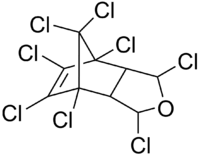Isobenzan
 | |
| Names | |
|---|---|
| IUPAC name
1,3,4,5,6,7,8,8-Octachloro-1,3,3a,4,7,7a-hexahydro-4,7-methanoisobenzofuran | |
| Other names
Telodrin; 1,3,4,5,6,7,8,8-Octachloro-4,7-methylene-3a,4,7,7a-tetrahydro-isobenzofuran | |
| Identifiers | |
| 297-78-9 | |
| 3D model (Jmol) | Interactive image |
| ECHA InfoCard | 100.005.497 |
| KEGG | C18960 |
| RTECS number | PC1225000 |
| |
| Properties | |
| C9H4Cl8O | |
| Molar mass | 411.73 g·mol−1 |
| Appearance | Whitish to light brown crystalline powder |
| Density | 1.87 g/cm3 |
| Melting point | 121.3 °C (250.3 °F; 394.4 K) |
| Practically insoluble | |
| Hazards | |
| EU classification (DSD) |
T+, N |
| R-phrases | R27/28 R50 |
| S-phrases | S28 S36/37 S45 S61 |
| NFPA 704 | |
| Flash point | Non-flammable |
| Except where otherwise noted, data are given for materials in their standard state (at 25 °C [77 °F], 100 kPa). | |
| | |
| Infobox references | |
Isobenzan (telodrin) is a highly toxic organochloride insecticide. It was produced only in the period from 1958 to 1965 and its use has been since discontinued.[1] It is a persistent organic pollutant that can remain in soil for 2 to 7 years, and the biological half-life of isobenzan in human blood is estimated to be about 2.8 years.[1]
It is classified as an extremely hazardous substance in the United States as defined in Section 302 of the U.S. Emergency Planning and Community Right-to-Know Act (42 U.S.C. 11002), and is subject to strict reporting requirements by facilities which produce, store, or use it in significant quantities.[3]
References
- 1 2 3 Isobenzan, International Programme on Chemical Safety
- ↑ Isobenzan at Sigma-Aldrich
- ↑ "40 C.F.R.: Appendix A to Part 355—The List of Extremely Hazardous Substances and Their Threshold Planning Quantities" (PDF) (July 1, 2008 ed.). Government Printing Office. Retrieved October 29, 2011.
This article is issued from Wikipedia - version of the 7/10/2016. The text is available under the Creative Commons Attribution/Share Alike but additional terms may apply for the media files.
